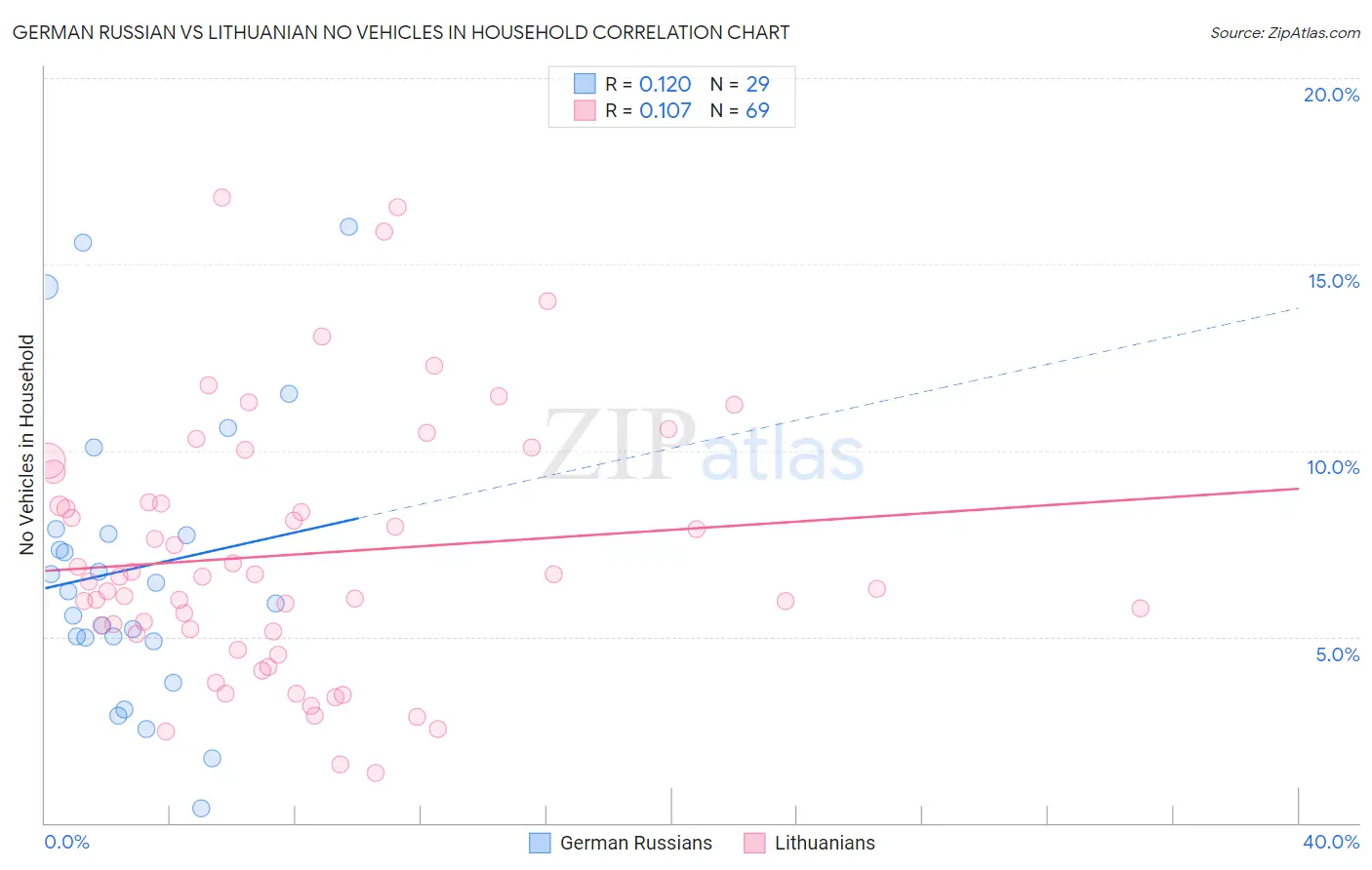German Russian vs Lithuanian No Vehicles in Household
COMPARE
German Russian
Lithuanian
No Vehicles in Household
No Vehicles in Household Comparison
German Russians
Lithuanians
10.5%
NO VEHICLES IN HOUSEHOLD
40.6/ 100
METRIC RATING
186th/ 347
METRIC RANK
8.4%
NO VEHICLES IN HOUSEHOLD
99.6/ 100
METRIC RATING
72nd/ 347
METRIC RANK
German Russian vs Lithuanian No Vehicles in Household Correlation Chart
The statistical analysis conducted on geographies consisting of 96,374,316 people shows a poor positive correlation between the proportion of German Russians and percentage of households with no vehicle available in the United States with a correlation coefficient (R) of 0.120 and weighted average of 10.5%. Similarly, the statistical analysis conducted on geographies consisting of 420,405,245 people shows a poor positive correlation between the proportion of Lithuanians and percentage of households with no vehicle available in the United States with a correlation coefficient (R) of 0.107 and weighted average of 8.4%, a difference of 24.9%.

No Vehicles in Household Correlation Summary
| Measurement | German Russian | Lithuanian |
| Minimum | 0.38% | 1.4% |
| Maximum | 16.0% | 16.8% |
| Range | 15.6% | 15.5% |
| Mean | 6.8% | 7.2% |
| Median | 6.2% | 6.6% |
| Interquartile 25% (IQ1) | 4.9% | 5.1% |
| Interquartile 75% (IQ3) | 7.8% | 9.0% |
| Interquartile Range (IQR) | 2.9% | 3.9% |
| Standard Deviation (Sample) | 3.9% | 3.5% |
| Standard Deviation (Population) | 3.8% | 3.4% |
Similar Demographics by No Vehicles in Household
Demographics Similar to German Russians by No Vehicles in Household
In terms of no vehicles in household, the demographic groups most similar to German Russians are South American (10.5%, a difference of 0.18%), Immigrants from Nepal (10.5%, a difference of 0.25%), Immigrants from Poland (10.6%, a difference of 0.31%), Native/Alaskan (10.5%, a difference of 0.42%), and Immigrants from Armenia (10.6%, a difference of 0.43%).
| Demographics | Rating | Rank | No Vehicles in Household |
| Ethiopians | 45.8 /100 | #179 | Average 10.5% |
| Arabs | 45.3 /100 | #180 | Average 10.5% |
| Immigrants | Colombia | 44.1 /100 | #181 | Average 10.5% |
| Immigrants | Bulgaria | 43.8 /100 | #182 | Average 10.5% |
| Natives/Alaskans | 43.7 /100 | #183 | Average 10.5% |
| Immigrants | Nepal | 42.4 /100 | #184 | Average 10.5% |
| South Americans | 41.9 /100 | #185 | Average 10.5% |
| German Russians | 40.6 /100 | #186 | Average 10.5% |
| Immigrants | Poland | 38.4 /100 | #187 | Fair 10.6% |
| Immigrants | Armenia | 37.5 /100 | #188 | Fair 10.6% |
| Immigrants | Eritrea | 36.3 /100 | #189 | Fair 10.6% |
| Immigrants | North Macedonia | 34.6 /100 | #190 | Fair 10.6% |
| Immigrants | Northern Europe | 33.1 /100 | #191 | Fair 10.7% |
| Carpatho Rusyns | 32.1 /100 | #192 | Fair 10.7% |
| Ukrainians | 28.0 /100 | #193 | Fair 10.7% |
Demographics Similar to Lithuanians by No Vehicles in Household
In terms of no vehicles in household, the demographic groups most similar to Lithuanians are Immigrants from Lebanon (8.4%, a difference of 0.030%), Polish (8.4%, a difference of 0.030%), Cajun (8.4%, a difference of 0.060%), Spaniard (8.4%, a difference of 0.78%), and Immigrants from Iran (8.4%, a difference of 0.84%).
| Demographics | Rating | Rank | No Vehicles in Household |
| Canadians | 99.7 /100 | #65 | Exceptional 8.3% |
| Palestinians | 99.7 /100 | #66 | Exceptional 8.3% |
| Immigrants | Scotland | 99.7 /100 | #67 | Exceptional 8.3% |
| Immigrants | Iran | 99.7 /100 | #68 | Exceptional 8.4% |
| Spaniards | 99.7 /100 | #69 | Exceptional 8.4% |
| Cajuns | 99.6 /100 | #70 | Exceptional 8.4% |
| Immigrants | Lebanon | 99.6 /100 | #71 | Exceptional 8.4% |
| Lithuanians | 99.6 /100 | #72 | Exceptional 8.4% |
| Poles | 99.6 /100 | #73 | Exceptional 8.4% |
| Cubans | 99.5 /100 | #74 | Exceptional 8.5% |
| Jordanians | 99.5 /100 | #75 | Exceptional 8.5% |
| Immigrants | Philippines | 99.5 /100 | #76 | Exceptional 8.5% |
| Iranians | 99.5 /100 | #77 | Exceptional 8.6% |
| Immigrants | South Central Asia | 99.5 /100 | #78 | Exceptional 8.6% |
| Portuguese | 99.5 /100 | #79 | Exceptional 8.6% |